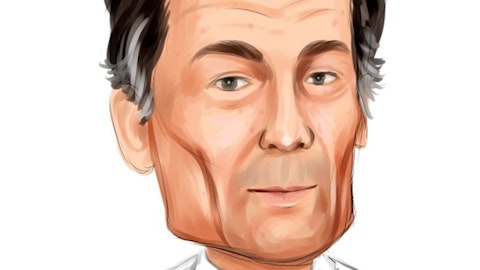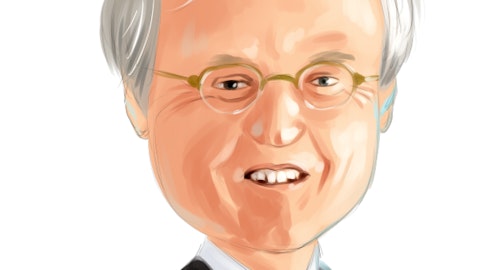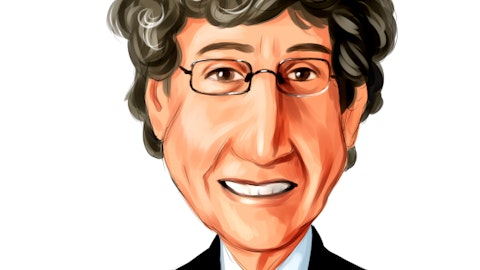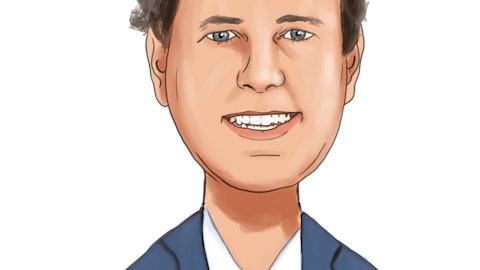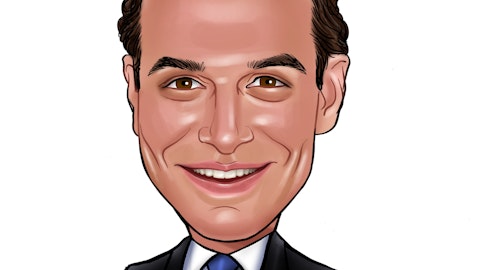SI-BONE, Inc. (NASDAQ:SIBN) Q4 2022 Earnings Call Transcript February 27, 2023
Operator: Good afternoon, and welcome to SI-BONE’s Fourth Quarter Earnings Conference Call. At this time, all participants are in a listen-only mode. We will be facilitating a question-and-answer session towards the end of today’s call. As a reminder, this call is being recorded for replay purposes. I would now like to turn the call over to Saqib Iqbal, Director of Investor Relations at SI-BONE’s introductory comments. Sir, you may begin.
Saqib Iqbal: Thank you for participating in today’s call. Joining me are Laura Francis, Chief Executive Officer; and Anshul Maheshwari, Chief Financial Officer. Earlier today, SI-BONE released financial results for the quarter ended December 31, 2022. A copy of the press release is available on the company’s website. Before we begin, I’d like to remind you that management will make statements during this call that include forward-looking statements within the meaning of federal securities laws which are made pursuant to the Safe Harbor provisions of the Private Securities Litigation Reform Act of 1995. Any statements contained in this call that relate to expectations or predictions of future events, results or performance are forward-looking statements.
These forward-looking statements are based on the company’s current expectations and inherently involve risks and uncertainties. These risks include the duration of secondary impact of the COVID-19 pandemic such as facility staffing shortages, whether the COVID-19 pandemic will recur in the future and our ability to effectively commercialize new products going forward. Other forward-looking statements include our examination of operating trends and our future financial expectations such as expectations for hiring, surgeon training and adoption, active surgeons, new products, clinical trial enrollment and reimbursement decisions and are based upon our current estimates and various assumptions. These statements involve material risks and uncertainties that could cause actual results or events to materially differ from those anticipated or implied by these forward-looking statements.
Accordingly, you should not place undue reliance on these statements. For a list and description of the risks and uncertainties associated with our business, please refer to the Risk Factors section of our most recent Form 10-K and Form 10-Q filed with the Securities and Exchange Commission. SI-BONE disclaims any intention or obligation, except as required by law, to update or revise any financial projections or forward-looking statements whether because of new information, future events or otherwise. This conference call contains time-sensitive information and is accurate only as of the live broadcast today, February 27, 2022. With that, I’ll turn the call over to Laura.
Laura Francis: Thanks, Saqib. Good afternoon and thank you for joining us. For today’s call, I’ll provide a business update and Anshul will provide additional detail regarding our financial results. I’m pleased with our strong finish in 2022 as we effectively navigated some macro challenges, drove steady reacceleration of the business and delivered record performance. As you may recall, our worldwide year-over-year revenue growth in 2022 went from 10% in Q1 to 15% in Q2 to 19% in Q3 and finally 27% in Q4. Our growth was driven by both our core SI-Joint fusion business, as well as new products targeted toward adult deformity and trauma applications. 2022 was a milestone year for the company as we extended our market leadership, expanded our addressable market with the launch of iFuse Bedrock Granite a breakthrough product and received expanded FDA clearance for applications of iFuse’s torque and fragility fractures and spino-pelvic fixation.
Our comprehensive portfolio allowed us to achieve record U.S. Active Surgeon growth, which we believe is crucial to deliver strong sustainable growth in 2023 and beyond. As we progressed through 2022, we delivered substantial operating leverage and significantly reduced our adjusted EBITDA loss and cash usage, while investing in our long-term growth initiatives. Before I discuss the details of our performance, I’d like to thank our employees for their dedication and focus to achieve these major milestones. You supported over 1,300 U.S. Surgeons, who performed a procedure using our solutions in 2022. Most importantly, you helped improve the quality of life for over 13,000 patients worldwide. Now moving to our performance. For the fourth quarter of 2022, our worldwide revenue was $32 million, reflecting 27% growth compared to the fourth quarter of 2021 and 21% growth compared to the third quarter of 2022.
Our U.S. revenue in the fourth quarter grew 28%, compared to the prior-year period to a record $30 million, driven by 33% procedure volume growth in the quarter. For the full-year 2022, we generated worldwide revenue of $106.4 million, reflecting 18% growth, compared to the full-year 2021. Our U.S. revenue grew over 19%, compared to full-year 2021 to $98.8 million. The sequential acceleration in our U.S. revenue growth in each quarter of 2022 reaffirmed strong demand for our solutions in a normalizing operating environment. Now let me provide some details on our key initiatives as we look to expand our leadership position and drive strong long-term growth. Starting with sales infrastructure. Our dedicated direct sales force and agent partners are an important driver of growth as we develop our core markets and grow our presence in trauma and adult deformity.
We ended 2022 with 88 territory managers and 73 clinical support specialists. In 2022, the average annual revenue per territory manager increased to $1.2 million, reflecting double-digit percentage growth, compared to 2021. We believe there is significant opportunity for operating leverage in 2023, given the potential for average territory productivity to be in the range of $1.5 million to $2 million over time. With our expanded portfolio, we’re leveraging our growing network of agents for case coverage and selectively evaluating consignment strategies at high-volume hospitals. We’re confident that this hybrid approach will help the territory manager drive surgeon engagement, ensure high-quality support for a surgeon and deliver strong productive top line growth.
Moving on to surgeon engagement. Surgeon adoption is one of the best leading indicators of long-term procedure demand. We exited the fourth quarter with a record 920 active surgeons. This equates to over 33% growth in our active surgeon base over the fourth quarter of 2021 and approximately 15% sequential growth, compared to the third quarter of 2022. This is the eighth consecutive quarter of double-digit year-over-year growth in our active surgeon base and the highest growth rate in active surgeon base since we’ve been a public company. This growth enacted surgeon base is a testament to our focus on surgeon engagement, education and outreach over the last several years. The increase in surgeons in the fourth quarter came from those who performed a minimally invasive SI joint fusion procedure, as well as adult deformity or trauma procedures.
Additionally, it’s exciting to see a growing surgeon overlap across our various procedures. In 2022, over half of our active surgeons, who performed an adult deformity procedure also performed a minimally invasive SI joint fusion procedure using our solutions. We believe our complementary portfolio provides a significant opportunity to drive deeper engagement with their active surgeon base and increase the procedures per surgeon. With the trauma indication expansions for iFuse-TORQ, the launch of iFuse Bedrock Granite and the growing interest in spino-pelvic fixation and fusion, surgeon education is crucial to drive engagement and activation. Additionally, we’re experiencing great success with our academic programs that are focused on residents and fellows.
Since the inception of the program, we’ve held training events in over 200 academic facilities in the United States and trained approximately 1,300 surgical residents as fellows. We’re encouraged by the steady adoption of our procedures by these previously trained fellows and residents when they began practicing. In 2022, the number of fellows and residents who did their first case increased nearly threefold, compared to 2021, while their procedure volumes increased fourfold. Turning to products and solutions. The key tenet of our strategy has been to expand our platform of sacropelvic solutions to a direct SI joint pain, adult deformity and trauma. With iFuse-3D, iFuse-TORQ and now iFuse Bedrock Granite, we believe it’s the value of our innovative, versatile and complementary product portfolio provides surgeons with a comprehensive set of alternatives and positions us as the top choice for surgeons for sacropelvic solutions.
iFuse-TORQ continues its strong growth and has become an important addition to the portfolio. TORQ provides an alternative to iFuse-3D for our existing surgeons and has allowed us to convert users of competitive screw systems as well as engage new surgeons performing minimally invasive SI joint fusion. Following the FDA clearance for iFuse-TORQ to include fusion in conjunction with spino-pelvic fixation, we’re seeing a steady uptake in the use of the product to complement iFuse Bedrock Granite as a second point of fixation as a joint. From a biomechanical perspective, having 2 points of fixations is important to attain fusion. In trauma, we’re in the early stages of market development and are encouraged by the progress in the use of iFuse-TORQ for sacral insufficiency fracture.
Based on our market analysis, many of our spine surgeons routinely see fragility fracture patients, providing us an opportunity to leverage existing relationships as we build this market. With approximately 120,000 of these injuries per year in the U.S., most of which are currently not treated surgically, the fragility fracture market is a recognized unmet clinical need. The trauma opportunity is of strategic importance to us as the sacropelvic solutions leader and will be an important avenue for growth over the long term. Moving to iFuse Bedrock Granite, the reception of iFuse Bedrock Granite has been exceptional, driven by strong surgeon and hospital interest in adopting the product. Based on our early interest, we believe that Granite may become a standard of care for stabilizing the base long construct in adult deformity procedures and in certain degenerative spinal fusion cases.
As I indicated earlier, we’re seeing several surgeons using some combination of our products to achieve 2 points of fixation across the SI joint on either side, resulting in a significant pull-through opportunity for the overall portfolio and higher procedure average selling price. This launch, nearly 2,500 hospitals across the U.S. have added iFuse Bedrock Granite to their approved products list. Additionally, with the recent FDA clearance to allow the use of iFuse Bedrock Granite with a variety of pedicle spring rod systems, surgeons can now have confidence using their preferred system with iFuse Bedrock Granite as the foundation for the construct. We believe both these milestones will be additional catalysts to drive future growth. Given the positive experience with iFuse Bedrock Granite, we’re seeing surgeons expand the use of the product to stabilize the base of shorter multilevel constructs as part of their treatment for degenerates spinal conditions.
Approximately one-third of our iFuse Bedrock Granite cases have been in these degenerative procedures. There are over 100,000 short multilevel spinal fusion procedures per year in the U.S. While still early, the expanded use of iFuse Bedrock Granite in the shorter multilevel spinal fusion procedures for fixation could be an exciting opportunity for us and could expand our total addressable market beyond our initially estimated $250 million. Before I hand it over to Anshul, I’d like to provide a reminder on the CMS rule for hospital outpatient and ASC payments that went effective January 1. In 2023, Medicare facility fees and minimally invasive procedures performed using CPT code 27279 and hospital outpatient or ASC settings increased by 33% to approximately $22,000 and 26% to approximately $17,000, respectively.
Today, 80% of our minimally invasive SI joint procedures are performed in an outpatient setting or at surgery centers. We expect more of our minimally invasive procedures to move to ASCs over time. While it is too early to assess the business impact of this significant increase in facility fees, we believe it could be a tailwind for demand and ASP stabilization at these sites serve. I’ll now turn the call over to Anshul to provide more detail on our financial results.
Anshul Maheshwari: Thanks, Laura. Good afternoon, everyone. My comments today will be focused on fourth quarter revenue growth, operating leverage and liquidity. Starting with revenue growth. Our fourth quarter total revenue was $32 million, representing growth of approximately 27%, compared to the prior year period and 21% sequentially. U.S. revenue was $30 million, increasing 28%, compared to the prior year period. Growth in the U.S. was driven by strong demand for our solutions, which resulted in approximately 33% procedure volume growth versus the prior-year period and 23% growth sequentially. ASC procedure volumes were in the low-20% range, consistent with the prior year period. International revenue was $2 million, reflecting growth of approximately 3% in U.S. dollars, compared to the prior year period.
Across Europe, France maintained strong performance offset by underperformance in Germany and the U.K. Gross margins for the fourth quarter of 2022 was 84%, in line with our third quarter gross margin. The fourth quarter gross margin reflects a low single-digit percentage impact from lower average selling price, increase in freight cost and higher cost of new products, as well as the increase in depreciation from the ongoing deployment of instrument trades to support strong new product demand. Moving to operating leverage. Operating expenses increased 7% to $38.2 million in the fourth quarter of 2022, as compared to $35.8 million in the prior-year period. The increase was driven by higher commissions associated with the revenue growth, increased travel and freight costs and higher investments in R&D.
On a sequential basis, operating expenses increased approximately 6%, driven by higher commissions associated with the higher revenue in the quarter. We’re pleased with the acceleration in operating leverage as our revenue growth rate was 4 times the operating expense growth rate in the fourth quarter. The operating leverage was driven by strong top line performance and across the board productivity gains from investments we have made to scale our platform over the last few years. Our net loss was $11.2 million or $0.32 per diluted share for the fourth quarter of 2022, as compared to a net loss of $14.5 million or $0.43 per diluted share in the prior-year period. Our adjusted EBITDA loss improved significantly in the second-half of 2022 with fourth quarter adjusted EBITDA loss of negative $4.2 million, an improvement of over 50% over the prior-year period.
Turning to liquidity. We exited 2022 with $97.3 million in cash and marketable securities. Our cash outflow steadily declined as we progressed through 2022. Our total cash outflow in the fourth quarter was $7 million, an improvement of approximately 51%, compared to the prior year period and an improvement of over 34%, compared to the third quarter of 2022. While we plan to make additional investments in instrument trades and implants to support our growth, we expect continued progress in operating leverage to moderate cash usage in 2023. In January of 2023, we refinanced the outstanding $35 million term loan with a new $51 million credit facility with Silicon Valley Bank, including a $36 million term loan and a $15 million revolving line of credit.
The new credit facility includes a $15 million accordion that is available to the company subject to the credit approval of the bank. The refinancing allows us to lower our borrowing costs, delay amortization by nearly two years and have access to additional liquidity, if needed. Finally, moving to our outlook for 2023. We continue to experience demand momentum for our comprehensive portfolio of solutions, as well as elevated surgeon engagement. However, we are being thoughtful in our approach to annual guidance given the early phase of reacceleration of the U.S. business and the pace of recovery in our international business. Considering these factors, we expect 2023 worldwide revenue of approximately $124 million to $127 million, implying year-over-year growth of approximately 17% to 19%.
In 2023, we expect gross margin to stabilize at approximately 80%. Our gross margin assumptions incorporate low single-digit ASP degradation, as well as additional depreciation expense from the deployment of iFuse Bedrock Granite and iFuse-TORQ trades in the back half of 2022 and throughout 2023. Turning to operating expenses. We anticipate operating expenses will grow at a mid-single-digit percentage rate in 2023. We foresee a reduction in adjusted EBITDA loss compared to the full year 2022 based on the strong top line growth and continued operating leverage. With that, I will turn the call over for questions. Operator?
See also Best Hot Stocks To Buy Now and 16 Best Mid-Cap Stocks To Buy.
Q&A Session
Follow Si-Bone Inc. (NASDAQ:SIBN)
Follow Si-Bone Inc. (NASDAQ:SIBN)
Operator: Thank you. Our first question comes from the line of Kyle Rose with Canaccord. Your line is open.
Kyle Rose: Hi, good afternoon, everybody. And thank you for taking the question. I just want to kind of dig in just on the gross margin guidance for a second here. 80%, I appreciate the commentary about the ASP decline and some higher depreciation costs. Maybe just talk a little bit more about the ASP stabilization that you’re seeing there? And just how we should interpret that from a long-term perspective when we think about the gross margin profile of the company?
Anshul Maheshwari: Kyle, this is Anshul. From a gross margin perspective, as you’ve seen over the last couple of years since we’ve introduced two new products, we have been putting a lot of investment in instrument trays to support what we see as strong demand for both TORQ and for Granite. And if you look at the PP&E line in our balance sheet, you will see that have gone up from about, say, $4 million-ish at the end of 2020 to north of $15 million at the end of 2022. Now these trays get depreciated over a three-year period. They obviously have a much longer lifespan that they are used for. But that’s about $4 million to $5 million of depreciation that goes to your gross margin line, which will equate to about 3 points to 4 points of gross margin deterioration.
A lot of the Granite investment came about in the second-half of 2022. We expect to continue to roll out additional Granite trays throughout 2023. So we took that into account as well. So I’d say a lot of the gross margin impact is driven by the depreciation of those instrument trays. Now on the ASP side, Kyle, we tend to make assumptions around based on what we’ve seen historically and sort of in the low-to-mid single-digit range ASP decline is what we always look at to sort of the 3% to 5%. And it’s still early days in the year, but we are seeing sort of be on the lower side of that ASP trend than we have historically been. So that’s how we’ve sort of framed our gross margin guidance.
Kyle Rose: Okay. Very helpful. And I appreciate the commentary about the new product launches. And I have to put the cart before the horse, so to speak, given you’re still early in the Granite and the TORQ launch. But what should we be expecting from a new product development perspective as the company focuses on being a larger pelvic reconstruction or pelvic ring focused company? What are the other areas that you think are underserved in the market that you think would be worth allocating R&D resources moving forward?
Laura Francis: Yes, Kyle, thanks for the question. And when we went public, we were a single product company focused on SI joint fusion. We’re the pioneer in that market. We’ve built that market, and we are, by far, the market leader in the space. And — but what we’ve been doing over the last few years is capturing the broader opportunity in sacropelvic solutions. And so we have launched products that provide us with opportunities in adult deformity as well as in trauma as well. So we’re seeing that strategy play out very well for us, and we do certainly have an additional pipeline of products that we’ll be speaking to at future dates. But right now, what we’re really focused on is market development of our core market and SI joint fusion, and we’re really pleased about the reacceleration that we’ve seen in our core market.

